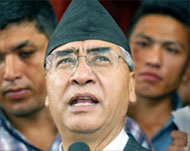Timeline: Nepal protests
Below is a chronology of key events in Nepal since Februray 1, 2005, when the monarch suspended a multi-party government and pledged to crush a Maoist revolt that has killed more than 13,000 people since 1996.

February 1, 2005 – King Gyanendra sacks the government of Sher Bahadur Deuba, the prime minister, then declares a state of emergency and takes power.
February 22 – India and Britain announce they have stopped military aid to Nepal, but India resumes non-lethal military supplies.
April 30 – The king ends the state of emergency but retains the powers he seized.
September 1 – The largest political party, Nepali Congress, drops a 60-year-old written pledge to uphold constitutional monarchy.
September 3 – Maoist rebels announce a unilateral, three-month ceasefire but the royalist government rejects the truce, saying the rebels could not be trusted.
November 22 – The seven main political parties and Maoists pledge to co-operate to end the absolute powers of the king.
December 2 – Rebels extend truce by one month; government rules out matching gesture.
 |
|
Deuba and his government were |
January 2, 2006 – Rebels end ceasefire, raising fears of renewed violence in the landlocked Himalayan nation.
February 1 – Street protests erupt across Nepal on the first anniversary of Gyanendra’s power seizure.
February 8 – Low turnout and protests mark local elections called by the king to convince people he is moving towards democracy.
February 19 – Gyanendra makes his first formal approach to the political parties, urging them to join talks to put democracy back on track. The opposition rejects the offer.
March 14 – The Maoists begin a road blockade that chokes supplies, raises prices of essential goods and causes fuel shortages. The blockade is withdrawn after six days.
April 4 – The royalist government indefinitely bans protests in Kathmandu, two days before a general strike. A night curfew is imposed and dozens of activists and politicians are detained.
April 9 – The strike, which was originally called for four days, is extended indefinitely as violent protests spread and three people are shot and killed by troops.
April 16 – The king holds talks with the US, Chinese and Indian ambassadors and indicates he could meet some of the protesters’ demands, but diplomats say they know of no specifics.
April 19 – At least two protesters are killed when security forces open fire, taking the toll from two weeks of demonstrations to at least eight.